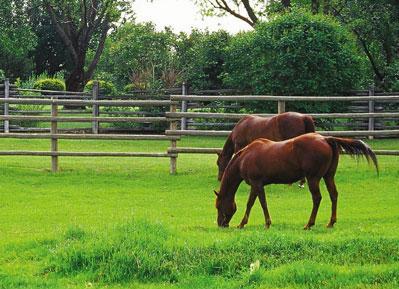Horses do some of their own pasture fertilizing, but hardly even or efficient. To encourage good pasture growth, fertilizer should be applied periodically and the type or amount should be based on a soil analysis done every couple of years.
For many pastures, an application of nitrogen in early spring can encourage lush growth and make a pasture last longer. A second application approximately 8 weeks after the first application will encourage warm weather growth.
Proper nitrogen fertilization of a grass pasture not only increases the amount of forage, but also the protein content. A Bermuda grass pasture that receives nitrogen may produce up to eight times as much forage with 2.4 times as much protein.
Pastures that contain more than 40% legumes (such as alfalfa or clover) likely will not need nitrogen. These plants manufacture soil nitrogen in their root nodules and fertilize themselves while benefiting the rest of the field as well. But many pastures don't have a high concentration of legumes because they don't make particularly hardy pasture plants.
A legume-rich pasture may require minerals such as phosphorus, potash or lime. Otherwise, the legumes may die out before the grass portion of the pasture. Other needed minerals may include magnesium, sulfur, and trace elements, such as copper, manganese, zinc and boron (which may be particularly beneficial if you plan to graze broodmares or young horses on the field).
To upgrade an existing pasture without starting from scratch, horse owners should consider "overseeding." An application of a "pasture mix" in early spring, at about half the density you would use if planting a new field can increase the density of nutritious forage without tilling the ground.
Frost seeding is a particularly effective approach as the seed is applied to the pasture when the ground is still frozen, but has no snow cover. When the soil warms in the spring, it heaves as the frost leaves it, drawing the pasture seeds into the earth and providing a better chance of germination. Horse owners may also want to go over a topseeded pasture with a roller or chain harrow to help plant surface-scattered seeds. After topseeding, allow at least a week for the seeds to germinate before returning horses to the pasture.








Post a comment
Report Abusive Comment